一、原理
ECDSA
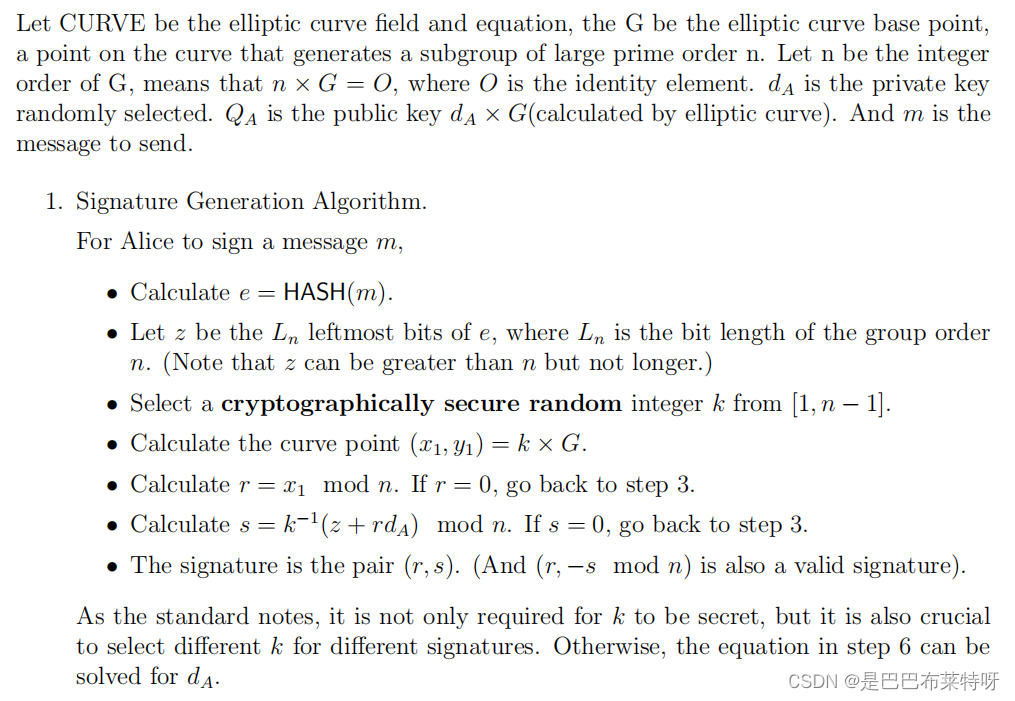
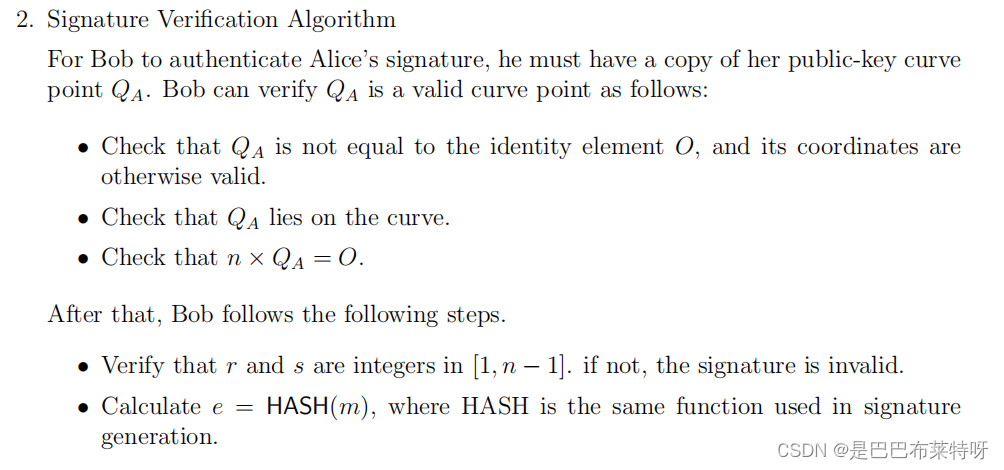

SM2
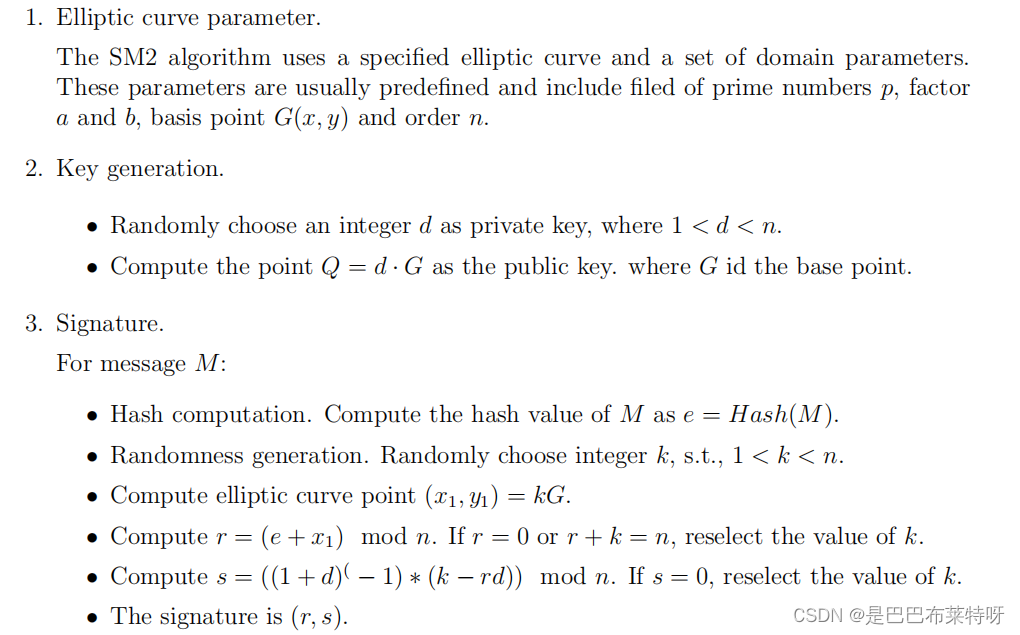
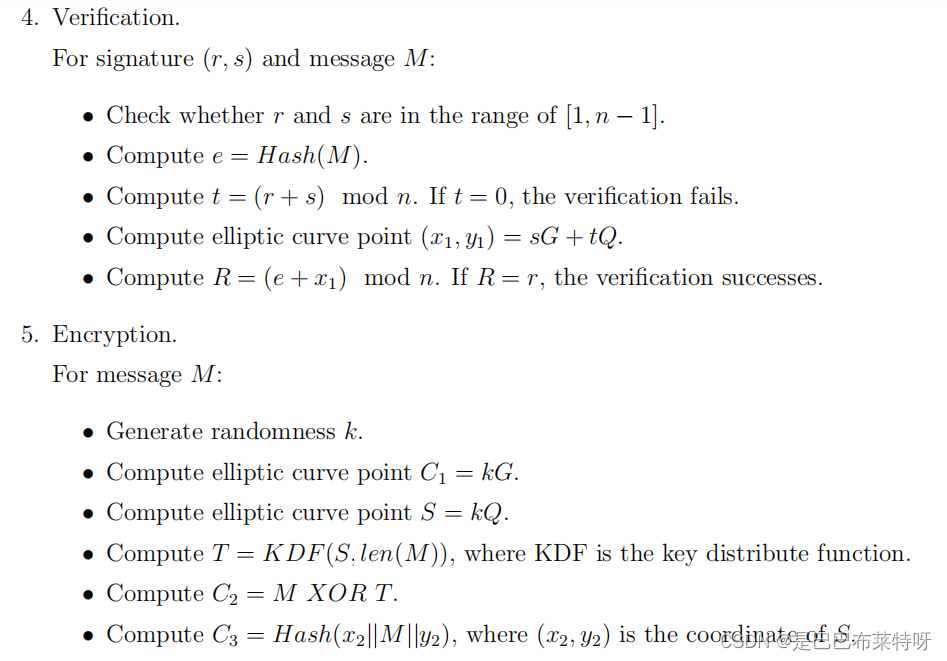

ElGamal
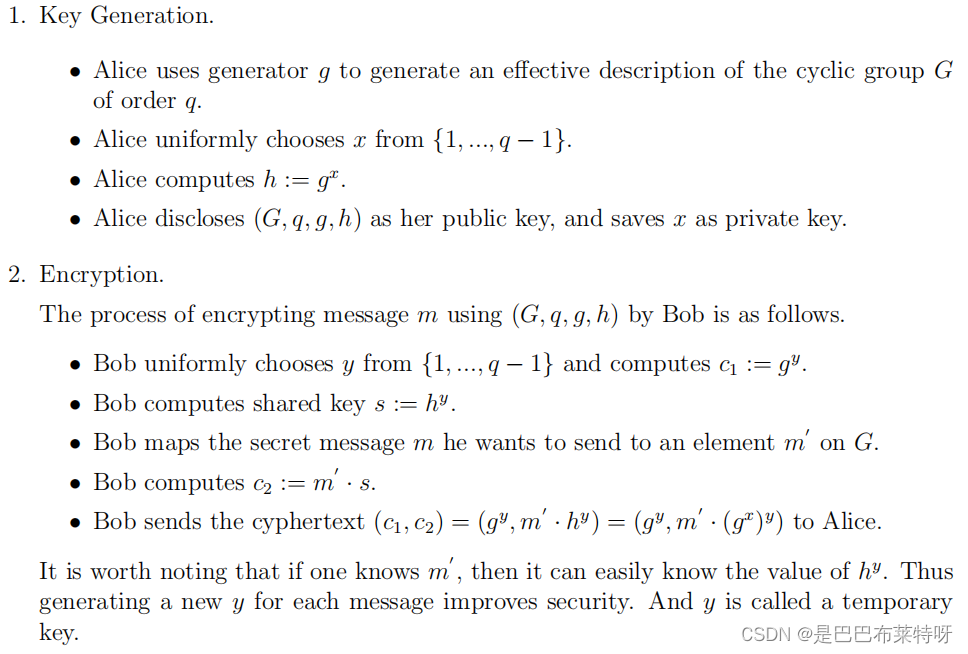

二、C/C++实现
头文件
POperation.h
#ifndef POPERATION_H
#define POPERATION_H
// 定义点的结构
typedef struct {
long long x;
long long y;
} Point;
// 定义椭圆曲线的结构
typedef struct {
long long a, b; // 曲线参数 y^2 = x^3 + ax + b
long long p; // 有限域的素数
} EllipticCurve;
// 模逆运算的函数声明
long long mod_inverse(long long a, long long m);
// 点加运算的函数声明
Point point_add(Point P, Point Q, EllipticCurve ec);
// 点乘运算的函数声明
Point point_multiply(long long scalar, Point P, EllipticCurve ec);
#endif // POPERATION_H
ECDSA.h
#ifndef ECDSA_H
#define ECDSA_H
#include "POperation.h" // 包含 EllipticCurve 和 Point 结构的定义
// ECDSA签名函数声明
void ecdsa_sign(char* message, long long d, EllipticCurve ec, Point G, long long n, long long* r, long long* s);
// ECDSA验证函数声明
int ecdsa_verify(char* message, Point Q, EllipticCurve ec, Point G, long long n, long long r, long long s);
// 简单哈希函数声明
long long simple_hash(char* message);
#endif // ECDSA_H
ElGamal.h
#ifndef ELGAMAL_H
#define ELGAMAL_H
#include <gmpxx.h>
#include <vector>
#include <iostream>
// 检测原根
bool is_primitive_root(const mpz_class& g, const mpz_class& p);
// 生成大质数和其原根
void generate_prime_and_primitive_root(mpz_class& p, mpz_class& g);
// 生成公钥和私钥
void generate_keys(mpz_class& p, mpz_class& g, mpz_class& y, mpz_class& x);
// 加密
void encrypt(const mpz_class& p, const mpz_class& g, const mpz_class& y, const mpz_class& m, mpz_class& c1, mpz_class& c2);
// 解密
void decrypt(const mpz_class& p, const mpz_class& x, const mpz_class& c1, const mpz_class& c2, mpz_class& m);
#endif // ELGAMAL_H
SM2.h
#pragma once
#ifndef SM2_H
#define SM2_H
#include <openssl/evp.h>
#include <openssl/ec.h>
#include <openssl/pem.h>
#include <openssl/err.h>
#include <iostream>
#include <cstring>
// 错误处理函数
void handleOpenSSLErrors();
// 生成SM2密钥对
EVP_PKEY* generateSM2KeyPair();
// SM2签名
bool sm2Sign(EVP_PKEY* pkey, const unsigned char* data, size_t dataLen, unsigned char** sig, size_t* sigLen);
#endif // SM2_H
源文件
POperation.cpp
#include <stdio.h>
#include <stdlib.h>
#include "POperation.h"
//typedef struct {
// long long x;
// long long y;
//} Point;
//
//typedef struct {
// long long a, b; // 曲线参数 y^2 = x^3 + ax + b
// long long p; // 有限域的素数
//} EllipticCurve;
// 模逆运算
long long mod_inverse(long long a, long long m) {
long long m0 = m, t, q;
long long x0 = 0, x1 = 1;
if (m == 1) {
return 0;
}
while (a > 1) {
q = a / m;
t = m;
m = a % m, a = t;
t = x0;
x0 = x1 - q * x0;
x1 = t;
}
if (x1 < 0) {
x1 += m0;
}
return x1;
}
// 点加运算
Point point_add(Point P, Point Q, EllipticCurve ec) {
Point R;
if (P.x == Q.x && P.y == Q.y) { // 点倍运算
if (P.y == 0) {
R.x = 0;
R.y = 0;
return R;
}
long long s = (3 * P.x * P.x + ec.a) * mod_inverse(2 * P.y, ec.p) % ec.p;
R.x = (s * s - 2 * P.x) % ec.p;
R.y = (s * (P.x - R.x) - P.y) % ec.p;
}
else { // 一般点加运算
if (P.x == Q.x) {
R.x = 0;
R.y = 0;
return R;
}
long long s = (Q.y - P.y) * mod_inverse(Q.x - P.x, ec.p) % ec.p;
R.x = (s * s - P.x - Q.x) % ec.p;
R.y = (s * (P.x - R.x) - P.y) % ec.p;
}
R.x = (R.x + ec.p) % ec.p;
R.y = (R.y + ec.p) % ec.p;
return R;
}
// 点乘运算
Point point_multiply(long long scalar, Point P, EllipticCurve ec) {
Point result = { 0, 0 }; // 无穷远点
Point temp = P;
while (scalar != 0) {
if (scalar % 2 != 0) {
if (result.x == 0 && result.y == 0) {
result = temp;
}
else {
result = point_add(result, temp, ec);
}
}
temp = point_add(temp, temp, ec);
scalar /= 2;
}
return result;
}
ECDSA.cpp
#include <stdio.h>
#include <stdlib.h>
#include <string.h>
#include "POperation.h" // 假设之前定义的椭圆曲线结构和函数在这个头文件中
#include "ECDSA.h"
// 简单的哈希函数(仅用于示例)
long long simple_hash(char* message) {
long long hash = 0;
while (*message) {
hash = (hash * 31 + *message) % LONG_MAX;
message++;
}
return hash;
}
void ecdsa_sign(char* message, long long d, EllipticCurve ec, Point G, long long n, long long* r, long long* s) {
long long z = simple_hash(message); // 获取消息的哈希值
long long k, x1, y1;
do {
k = rand() % (n - 1) + 1; // 随机数 k
Point kG = point_multiply(k, G, ec); // 计算 k * G
x1 = kG.x; y1 = kG.y;
*r = x1 % n;
} while (*r == 0);
long long k_inv = mod_inverse(k, n);
*s = (k_inv * (z + *r * d)) % n;
if (*s == 0) {
ecdsa_sign(message, d, ec, G, n, r, s); // 如果 s 为 0,则重新签名
}
}
int ecdsa_verify(char* message, Point Q, EllipticCurve ec, Point G, long long n, long long r, long long s) {
if (r <= 0 || r >= n || s <= 0 || s >= n) {
return 0; // 验证 r 和 s 是否在合法范围内
}
long long z = simple_hash(message); // 获取消息的哈希值
long long w = mod_inverse(s, n);
long long u1 = (z * w) % n;
long long u2 = (r * w) % n;
Point u1G = point_multiply(u1, G, ec);
Point u2Q = point_multiply(u2, Q, ec);
Point P = point_add(u1G, u2Q, ec);
if (P.x == LONG_MAX && P.y == LONG_MAX) {
return 0; // 如果 P 是无穷远点
}
return (P.x % n == r); // 验证 r 是否等于 P.x mod n
}
ElGamal.cpp
#include <gmpxx.h>
#include <cstdlib>
#include <ctime>
#include <vector>
#include <iostream>
#include "ElGamal.h"
using namespace std;
// 检测原根
bool is_primitive_root(const mpz_class& g, const mpz_class& p) {
vector<mpz_class> factors;
mpz_class phi = p - 1;
mpz_class n = phi;
// 计算p - 1的所有质因数
for (mpz_class i = 2; i * i <= n; ++i) {
if (n % i == 0) {
factors.push_back(i);
while (n % i == 0)
n /= i;
}
}
if (n > 1)
factors.push_back(n);
for (mpz_class factor : factors) {
mpz_class res;
mpz_powm(res.get_mpz_t(), g.get_mpz_t(), mpz_class(phi / factor).get_mpz_t(), p.get_mpz_t());
if (res == 1)
return false;
}
return true;
}
// 生成大质数和其原根
void generate_prime_and_primitive_root(mpz_class& p, mpz_class& g) {
// 生成大质数
gmp_randclass rr(gmp_randinit_default);
rr.seed(time(NULL));
p = rr.get_z_bits(512);
mpz_nextprime(p.get_mpz_t(), p.get_mpz_t());
// 寻找原根
g = 2;
while (!is_primitive_root(g, p))
g += 1;
}
// 生成公钥和私钥
void generate_keys(mpz_class& p, mpz_class& g, mpz_class& y, mpz_class& x) {
// 随机生成大质数p和其原根g
// 由于寻找原根的效率问题,这里简化为固定的质数和原根
p = 23; // 实际应用中应该是大质数
g = 5; // 实际应用中应该是p的原根
// 随机选择私钥x
x = rand() % (p - 2) + 1;
// 计算公钥y
mpz_powm(y.get_mpz_t(), g.get_mpz_t(), x.get_mpz_t(), p.get_mpz_t());
}
// 加密
void encrypt(const mpz_class& p, const mpz_class& g, const mpz_class& y, const mpz_class& m, mpz_class& c1, mpz_class& c2) {
mpz_class k = rand() % (p - 1) + 1; // 随机选择k
mpz_class s;
// 计算c1
mpz_powm(c1.get_mpz_t(), g.get_mpz_t(), k.get_mpz_t(), p.get_mpz_t());
// 计算s (共享密钥)
mpz_powm(s.get_mpz_t(), y.get_mpz_t(), k.get_mpz_t(), p.get_mpz_t());
// 计算c2
c2 = (m * s) % p;
}
// 解密
void decrypt(const mpz_class& p, const mpz_class& x, const mpz_class& c1, const mpz_class& c2, mpz_class& m) {
mpz_class s, s_inv;
// 计算s (共享密钥)
mpz_powm(s.get_mpz_t(), c1.get_mpz_t(), x.get_mpz_t(), p.get_mpz_t());
// 计算s的逆
mpz_invert(s_inv.get_mpz_t(), s.get_mpz_t(), p.get_mpz_t());
// 解密消息
m = (c2 * s_inv) % p;
}
SM2.cpp
#include "openssl/evp.h"
#include "openssl/ec.h"
#include "openssl/pem.h"
#include <iostream>
#include <cstring>
#include "SM2.h"
// 错误处理
void handleOpenSSLErrors() {
ERR_print_errors_fp(stderr);
abort
();
}
// 生成SM2密钥对
EVP_PKEY* generateSM2KeyPair() {
EVP_PKEY_CTX* pctx = EVP_PKEY_CTX_new_id(EVP_PKEY_EC, nullptr);
EVP_PKEY* pkey = nullptr;
if (EVP_PKEY_keygen_init(pctx) <= 0) {
handleOpenSSLErrors();
}
if (EVP_PKEY_CTX_set_ec_paramgen_curve_nid(pctx, NID_sm2) <= 0) {
handleOpenSSLErrors();
}
if (EVP_PKEY_keygen(pctx, &pkey) <= 0) {
handleOpenSSLErrors();
}
EVP_PKEY_CTX_free(pctx);
return pkey;
}
// SM2签名
bool sm2Sign(EVP_PKEY* pkey, const unsigned char* data, size_t dataLen, unsigned char** sig, size_t* sigLen) {
EVP_MD_CTX* mdctx = EVP_MD_CTX_new();
EVP_PKEY_CTX* pctx = nullptr;
bool result = false;
if (EVP_DigestSignInit(mdctx, &pctx, EVP_sm3(), nullptr, pkey) <= 0) {
handleOpenSSLErrors();
}
if (EVP_DigestSign(mdctx, nullptr, sigLen, data, dataLen) <= 0) {
handleOpenSSLErrors();
}
*sig = (unsigned char*)OPENSSL_malloc(*sigLen);
if (EVP_DigestSign(mdctx, *sig, sigLen, data, dataLen) <= 0) {
handleOpenSSLErrors();
}
else {
result = true;
}
EVP_MD_CTX_free(mdctx);
return result;
}
ECCtest.cpp
main.c
//#include "ecc.h"
//#include <stdio.h>
//
//int main() {
// EllipticCurve ec = {/* 初始化曲线参数 */ };
// Point p = {/* 初始化点 */ };
//
// // 测试点乘
// Point result = point_multiply(2, p, ec);
// printf("Result of Point Multiply: (%lld, %lld)\n", result.x, result.y);
//
// // 测试ECDSA签名和验证
//
// return 0;
//}
#include<cstdio>
#include <gmp.h>
#include <time.h>
//#include "openssl/ec.h"
//#include "openssl/evp.h"
#include "POperation.h"
#include "SM2.h"
#include "ECDSA.h"
#include "ElGamal.h"
#define P "23"
#define G "5"
int main() {
示例:定义椭圆曲线参数和点
//EllipticCurve ec = { 1, 6, 11 }; // 曲线 y² = x³ + x + 6 (mod 11)
//Point P = { 2, 4 }; // 初始点
执行点乘运算
//Point Q = point_multiply(3, P, ec);
//printf("3P = (%lld, %lld)\n", Q.x, Q.y);
执行点加运算
//Point R = point_add(P, Q, ec);
//printf("P + 3P = (%lld, %lld)\n", R.x, R.y);
//auto key = EC_KEY_new_by_curve_name(NID_secp256k1);
//EC_KEY_generate_key(key);
//unsigned char* pub_key = nullptr;
//auto size = i2o_ECPublicKey(key, &pub_key);
//for (int i = 0; i < size; ++i) {
// std::printf("%02x", pub_key[i]);
//}
// EC_KEY_free(key);
ECDSA sign and verify
// // 定义椭圆曲线参数(简化版secp256k1)
//EllipticCurve ec = { 0, 7, 17 }; // y^2 = x^3 + 7 (mod 17)
//Point G = { 1, 1 }; // 基点G
//long long n = 19; // 基点的阶
定义私钥(随机选取,但必须小于n)
//long long d = 13; // 私钥
计算公钥
//Point Q = point_multiply(d, G, ec);
要签名的消息
//char message[] = "Hello, ECDSA!";
签名
//long long r, s;
//ecdsa_sign(message, d, ec, G, n, &r, &s);
//printf("Signature:\n");
//printf("r: %lld\n", r);
//printf("s: %lld\n", s);
验证
//int valid = ecdsa_verify(message, Q, ec, G, n, r, s);
//if (valid) {
// printf("Signature is valid.\n");
//}
//else {
// printf("Signature is invalid.\n");
//}
SM2加密和签名
//OpenSSL_add_all_algorithms();
//ERR_load_crypto_strings();
生成密钥对
//EVP_PKEY* pkey = generateSM2KeyPair();
要签名的数据
//const char* data = "Hello, SM2!";
//unsigned char* sig = nullptr;
//size_t sigLen = 0;
签名
//if (sm2Sign(pkey, (const unsigned char*)data, strlen(data), &sig, &sigLen)) {
// std::cout << "Signature successful!" << std::endl;
//}
//else {
// std::cout << "Signature failed!" << std::endl;
//}
清理
//OPENSSL_free(sig);
//EVP_PKEY_free(pkey);
//EVP_cleanup();
//ERR_free_strings();
//ElGamal测试
mpz_t p, g, x, y, m, c1, c2, decrypted_m;
mpz_inits(p, g, x, y, m, c1, c2, decrypted_m, NULL);
// 设置p和g
mpz_set_str(p, P, 10);
mpz_set_str(g, G, 10);
// 生成密钥
generate_keys(p, g, x, y);
gmp_printf("Public Key (y): %Zd\n", y);
gmp_printf("Private Key (x): %Zd\n", x);
// 设置消息m
mpz_set_ui(m, 13); // 设置一个示例消息
// 加密消息
encrypt(p, g, y, m, c1, c2);
gmp_printf("Encrypted Message (c1, c2): (%Zd, %Zd)\n", c1, c2);
// 解密消息
decrypt(p, x, c1, c2, decrypted_m);
gmp_printf("Decrypted Message: %Zd\n", decrypted_m);
mpz_clears(p, g, x, y, m, c1, c2, decrypted_m, NULL);
return 0;
}
三、运行结果
POperation测试

SM2测试

ECDSA测试


































 6177
6177











 被折叠的 条评论
为什么被折叠?
被折叠的 条评论
为什么被折叠?










